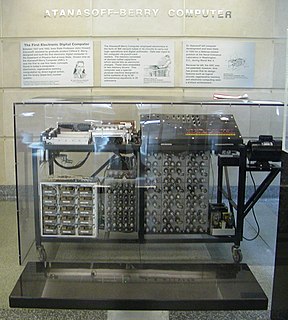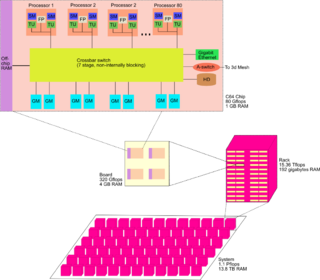Related Research Articles

A superscalar processor is a CPU that implements a form of parallelism called instruction-level parallelism within a single processor. In contrast to a scalar processor that can execute at most one single instruction per clock cycle, a superscalar processor can execute more than one instruction during a clock cycle by simultaneously dispatching multiple instructions to different execution units on the processor. It therefore allows for more throughput than would otherwise be possible at a given clock rate. Each execution unit is not a separate processor, but an execution resource within a single CPU such as an arithmetic logic unit.

Parallel computing is a type of computation in which many calculations or processes are carried out simultaneously. Large problems can often be divided into smaller ones, which can then be solved at the same time. There are several different forms of parallel computing: bit-level, instruction-level, data, and task parallelism. Parallelism has long been employed in high-performance computing, but has gained broader interest due to the physical constraints preventing frequency scaling. As power consumption by computers has become a concern in recent years, parallel computing has become the dominant paradigm in computer architecture, mainly in the form of multi-core processors.
Flynn's taxonomy is a classification of computer architectures, proposed by Michael J. Flynn in 1966. and extended in 1972. The classification system has stuck, and it has been used as a tool in design of modern processors and their functionalities. Since the rise of multiprocessing central processing units (CPUs), a multiprogramming context has evolved as an extension of the classification system. Vector processing, covered by Duncan's taxonomy, is missing from Flynn's work because the Cray-1 was released in 1977: Flynn's second paper was published in 1972.

Instruction-level parallelism (ILP) is the parallel or simultaneous execution of a sequence of instructions in a computer program. More specifically ILP refers to the average number of instructions run per step of this parallel execution.
In grammar, parallelism, also known as parallel structure or parallel construction, is a balance within one or more sentences of similar phrases or clauses that have the same grammatical structure. The application of parallelism affects readability and may make texts easier to process.
In computing, a parallel programming model is an abstraction of parallel computer architecture, with which it is convenient to express algorithms and their composition in programs. The value of a programming model can be judged on its generality: how well a range of different problems can be expressed for a variety of different architectures, and its performance: how efficiently the compiled programs can execute. The implementation of a parallel programming model can take the form of a library invoked from a sequential language, as an extension to an existing language, or as an entirely new language.
Concurrent computing is a form of computing in which several computations are executed concurrently—during overlapping time periods—instead of sequentially—with one completing before the next starts.
In computer programming, explicit parallelism is the representation of concurrent computations by means of primitives in the form of special-purpose directives or function calls. Most parallel primitives are related to process synchronization, communication or task partitioning. As they seldom contribute to actually carry out the intended computation of the program, their computational cost is often considered as parallelization overhead.
In computer science, implicit parallelism is a characteristic of a programming language that allows a compiler or interpreter to automatically exploit the parallelism inherent to the computations expressed by some of the language's constructs. A pure implicitly parallel language does not need special directives, operators or functions to enable parallel execution, as opposed to explicit parallelism.

A cellular architecture is a type of computer architecture prominent in parallel computing. Cellular architectures are relatively new, with IBM's Cell microprocessor being the first one to reach the market. Cellular architecture takes multi-core architecture design to its logical conclusion, by giving the programmer the ability to run large numbers of concurrent threads within a single processor. Each 'cell' is a compute node containing thread units, memory, and communication. Speed-up is achieved by exploiting thread-level parallelism inherent in many applications.
A parallel database system seeks to improve performance through parallelization of various operations, such as loading data, building indexes and evaluating queries. Although data may be stored in a distributed fashion, the distribution is governed solely by performance considerations. Parallel databases improve processing and input/output speeds by using multiple CPUs and disks in parallel. Centralized and client–server database systems are not powerful enough to handle such applications. In parallel processing, many operations are performed simultaneously, as opposed to serial processing, in which the computational steps are performed sequentially. Parallel databases can be roughly divided into two groups, the first group of architecture is the multiprocessor architecture, the alternatives of which are the following:

Data parallelism is parallelization across multiple processors in parallel computing environments. It focuses on distributing the data across different nodes, which operate on the data in parallel. It can be applied on regular data structures like arrays and matrices by working on each element in parallel. It contrasts to task parallelism as another form of parallelism.
Task parallelism is a form of parallelization of computer code across multiple processors in parallel computing environments. Task parallelism focuses on distributing tasks—concurrently performed by processes or threads—across different processors. In contrast to data parallelism which involves running the same task on different components of data, task parallelism is distinguished by running many different tasks at the same time on the same data. A common type of task parallelism is pipelining which consists of moving a single set of data through a series of separate tasks where each task can execute independently of the others.

In computer architecture, multithreading is the ability of a central processing unit (CPU) to provide multiple threads of execution concurrently, supported by the operating system. This approach differs from multiprocessing. In a multithreaded application, the threads share the resources of a single or multiple cores, which include the computing units, the CPU caches, and the translation lookaside buffer (TLB).
Explicit data graph execution, or EDGE, is a type of instruction set architecture (ISA) which intends to improve computing performance compared to common processors like the Intel x86 line. EDGE combines many individual instructions into a larger group known as a "hyperblock". Hyperblocks are designed to be able to easily run in parallel.
Bit-level parallelism is a form of parallel computing based on increasing processor word size. Increasing the word size reduces the number of instructions the processor must execute in order to perform an operation on variables whose sizes are greater than the length of the word.
Loop-level parallelism is a form of parallelism in software programming that is concerned with extracting parallel tasks from loops. The opportunity for loop-level parallelism often arises in computing programs where data is stored in random access data structures. Where a sequential program will iterate over the data structure and operate on indices one at a time, a program exploiting loop-level parallelism will use multiple threads or processes which operate on some or all of the indices at the same time. Such parallelism provides a speedup to overall execution time of the program, typically in line with Amdahl's law.
In computer science, deadlock prevention algorithms are used in concurrent programming when multiple processes must acquire more than one shared resource. If two or more concurrent processes obtain multiple resources indiscriminately, a situation can occur where each process has a resource needed by another process. As a result, none of the processes can obtain all the resources it needs, so all processes are blocked from further execution. This situation is called a deadlock. A deadlock prevention algorithm organizes resource usage by each process to ensure that at least one process is always able to get all the resources it needs. One such example of deadlock algorithm is Banker's algorithm.
In parallel computing, granularity of a task is a measure of the amount of work which is performed by that task.
Tse-yun Feng suggested the use of degree of parallelism to classify various computer architecture. It is based on sequential and parallel operations at a bit and word level.
References
- ↑ "Cornell Virtual Workshop: SIMD and Micro-Parallelism". cvw.cac.cornell.edu. Retrieved 2020-08-06.